#Hokkaidō Records
Explore tagged Tumblr posts
Text
For #WorldMigratoryBirdDay:
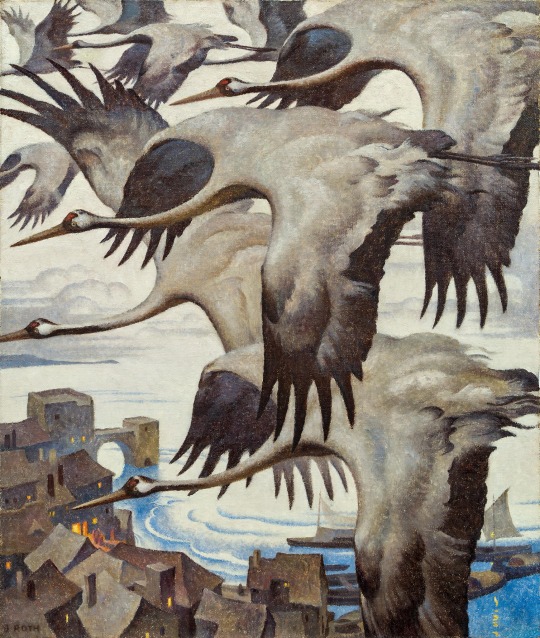
Norbertine Bresslern-Roth (Austrian, 1891-1978)
Crane migration, before March 1937
oil on jute, 120 × 100 cm
🆔 Red-Crowned Crane (Grus japonensis)
“In the spring & summer, the migratory populations of the red-crowned crane breed in Siberia (far E Russia), NE China, & occasionally in NE Mongolia (i.e., Mongol Daguur Strictly Protected Area). The breeding range centers in Lake Khanka, on the border of China & Russia. Later, in the fall, they migrate in flocks to the Korean Peninsula & E central China to spend the winter. Vagrants have also been recorded in Taiwan. In addition to the migratory populations, a resident population is found in eastern Hokkaidō, Japan.”
#animals in art#animal holiday#european art#20th century art#birds in art#bird#painting#birds#crane#cranes#Red-Crowned Crane#flock#migration#World Migratory Bird Day#oil painting#Norbertine Bresslern-Roth#women artists#ornithology
65 notes
·
View notes
Text
Events 1.27 (after 1970)
1973 – The Paris Peace Accords officially ends the Vietnam War. Colonel William Nolde is killed in action becoming the conflict's last recorded American combat casualty. 1980 – Through cooperation between the U.S. and Canadian governments, six American diplomats secretly escape hostilities in Iran in the culmination of the Canadian Caper. 1983 – The pilot shaft of the Seikan Tunnel, the world's longest sub-aqueous tunnel (53.85 km) between the Japanese islands of Honshū and Hokkaidō, breaks through. 1996 – In a military coup, Colonel Ibrahim Baré Maïnassara deposes the first democratically elected president of Niger, Mahamane Ousmane. 1996 – Germany first observes the International Holocaust Remembrance Day. 2002 – An explosion at a military storage facility in Lagos, Nigeria, kills at least 1,100 people and displaces over 20,000 others. 2003 – The first selections for the National Recording Registry are announced by the Library of Congress. 2010 – The 2009 Honduran constitutional crisis ends when Porfirio Lobo Sosa becomes the new President of Honduras. 2010 – Apple announces the iPad. 2011 – Arab Spring: The Yemeni Revolution begins as over 16,000 protestors demonstrate in Sana'a. 2011 – Within Ursa Minor, H1504+65, a white dwarf with the hottest known surface temperature in the universe at 200,000 K, was documented. 2013 – Two hundred and forty-two people die in a nightclub fire in the Brazilian city of Santa Maria, Rio Grande do Sul. 2014 – Rojava conflict: The Kobanî Canton declares its autonomy from the Syrian Arab Republic. 2017 – A naming ceremony for the chemical element tennessine takes place in the United States. 2023 – Protests and public outrage spark across the U.S. after the release of multiple videos by the Memphis Police Department showing officers punching, kicking, and pepper spraying Tyre Nichols as a result of running away from a traffic stop, which resulted him dying in the hospital three days later after the incident. 2023 – A shooting at a synagogue in Neve Yaakov, East Jerusalem, kills seven people and injures three others.
0 notes
Text

桜前線 「さくらぜんせん」 (sakura zensen) 🍒🌸
It means the cherry blossom front. The Japan Meteorological Agency records the opening and full bloom of the blossoms from Kyūshū in late March to Hokkaidō in the middle of May. I wrote this kanji because the cherry blossom season has started in Japan.
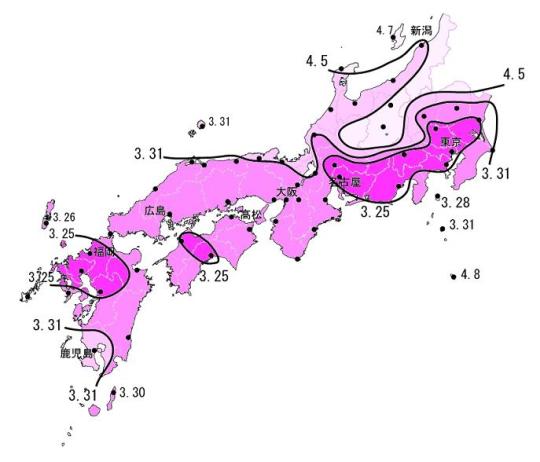
The cherry blossom front between Kyushu and Kanto, 2007
0 notes
Text
Timeline data hunting 5
Some more datas I found about the timeline...
1617: Alluvial gold was discovered in a river valley 18 km north of Matsumae, Ezo’s first and only castle town, causing a gold rush in Hokkaido.
1669 (June-October): The Ainu, under the leadership of Shakushain, revolt against Japanese, due to the Japanese trying to trade with them in an unfair manner and due to the Japanese gold-panners polluting the rivers badly enough to endanger the salmon. The Ainu marched from Shizunai to Matsumae castle, advancing west along the coast, torching Japanese boats and huts as they went, slaughtering gold prospectors, merchants and fishermen unlucky enough to cross their path. The rampage spread from Kushiro in the east to Rumoi in the northwest. The Japanese forces massed at Oshamambe, 130 km north of Matsumae. The two opposing armies faced each other across a river. Ainu arrows were no match for Japanese guns. Routed, the Ainu retreated. In October, Shakushain was murdered en route to what he thought was a peace parley.
4 December 1868 - 27 June 1869: Battle of Hakodate in which Hijikata supposedly 'died'. (chap 7)
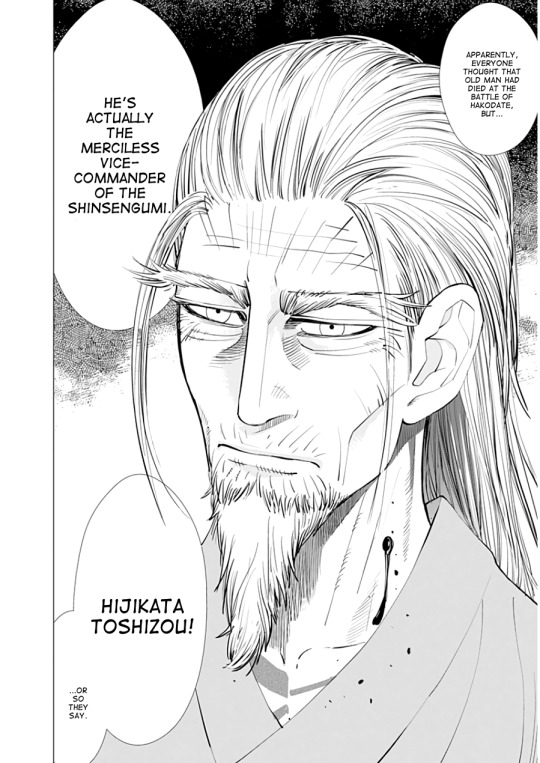
1874: The tondenhei (屯田兵), military settler colonists recruited to develop and defend Japan's northern frontier in Hokkaidō against foreign nations, particularly Imperial Russia, start being recruited. All male settlers between 18 and 35 were assigned to regiments.
1875 (May 7): Treaty of Saint Petersburg. A treaty between the Empire of Japan and Empire of Russia in which Japan cedes to Russia the part of Sakhalin island it then owned in exchange for the group of the Kuril Islands owned by Russia. As a result the majority of Ainu living in Wilk's village left for Japan. (Chap 148)
1877: Ainu are forced to oblige to the regulations for deer hunting areas, deer hunting season, and deer hunting practices that were made in 1876, but previously had excepted the Ainu. In addition to this it's instituted a licensing requirement for deer hunting with a license fee of 2.50 yen.
1878: The taking of salmon is first prohibited in the Sapporo area under the colonial governor's order then this prohibition was expanded gradually.
1879: The weather pattern during winter was abnormal becoming one of the factors that caused the extinction of the Hokkaido Wolf (Chap 22).

1880 (February): A particularly heavy snowfall led to many deer freezing to death.
1881 (March 13): In St. Petersburg Emperor Alexander II is assassinated by the joint efforts of Kiroranke and Wilk following the plan of Sofia "Golden Hand". (Chap 160)
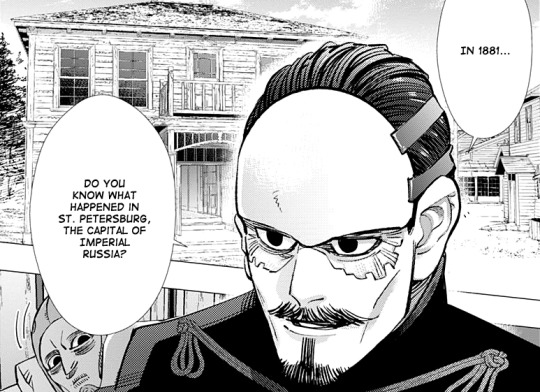
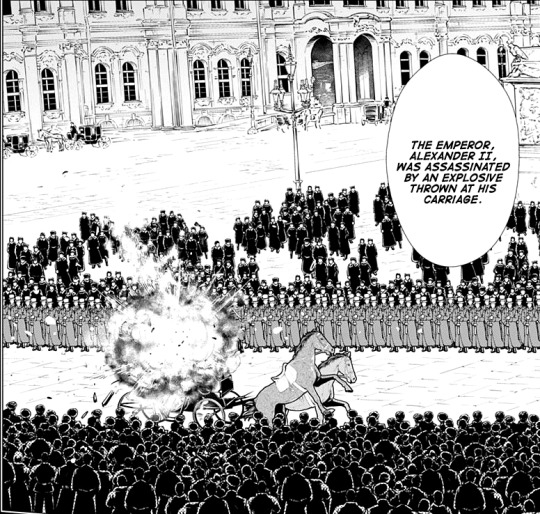
1882: the Imperial Japanese Army assumed control of the units of military settler colonists.
1888 (May 12): The 7th Division is formed in Sapporo, as the first new infantry division to be created after the reorganization of the Imperial Japanese Army away from six regional commands and into a divisional command structure. It was responsible for the defence of Hokkaidō, which it divided into four operational areas (Sapporo, Hakodate, Asahikawa and Kushiro). As one of the projects of the Japanese government was to encourage the settlement of Hokkaidō by ex-soldiers, the 7th Division was over-strength, and contained many soldiers originally from other areas of Japan.
1889: The regulation act of hunting deer forbids Ainu from hunting deer with poisoned arrows.
1890: Coal was discovered at Yubari.
25 July 1894 – 17 April 1895: The First Sino-Japanese War to which Tsukishima and Tsurumi take part (Chap 149).
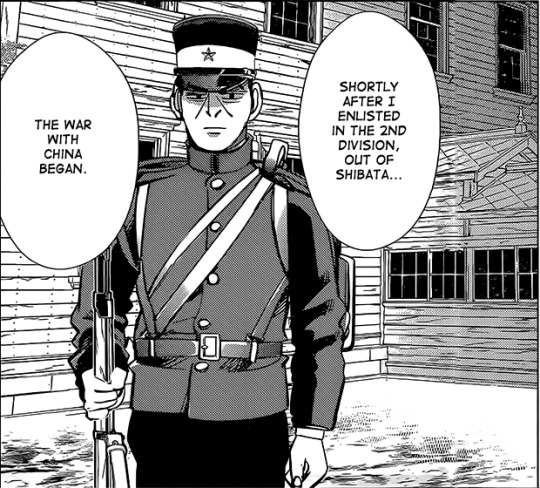
Nihei's son also takes part to it and dies during it (Chap 114).
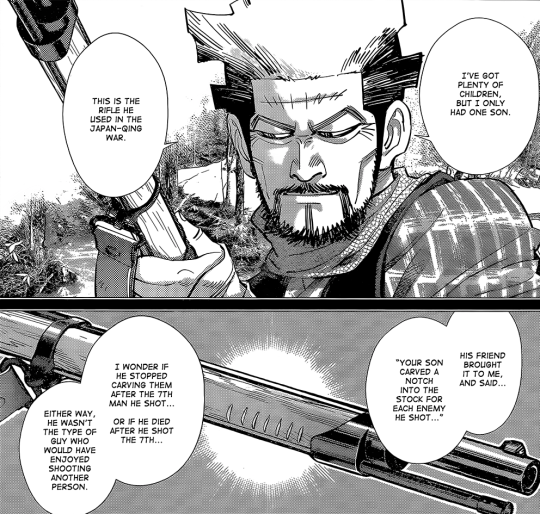
1996 (May 12): The t7th division is converted from territorial division to field infantry division 12 May 1896, in the aftermath of the First Sino-Japanese War.
1896: Tsukishima is imprisoned for parricide and met Tsurumi, who had been transferred to the 7th division, while being in jail (Chap 149)
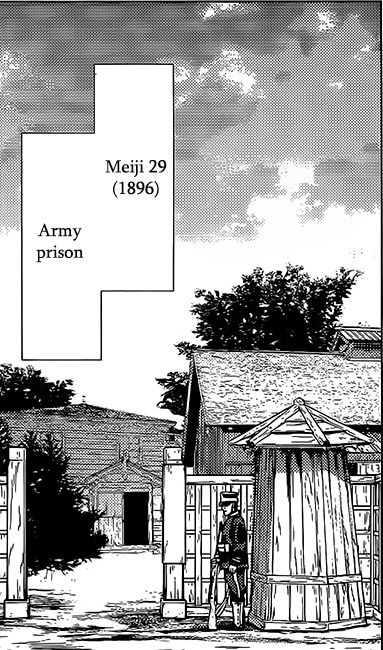
Tsurumi will work to get Tsukishima out of jail, planning to take him in Russia where they’ll both work as intelligence officers.

Last written record of wolves in Hokkaido. (Chap 29)

The 'River act' (1896) prohibites fishing for salmons in all Hokkaido.
1897 (?): Nihei and Kirawus go to hunt together and Nihei explains him the story behind his rifle. (Chap 114) (we know it happened around 10 years before Tanigaki met Kirawus. We can speculate Golden Kamuy started around 1907... if we are still in the same year this would make the meeting happened around 1897).

In between 1897 (?) & 1902 (?): Four guys go around murdering hunters and stealing their prey. They target Asirpa and her father but they manage to have one of them arrested. However when they target Nihei he manages to kill the remaining three, although for this he's sent to Abashiri prison. (Chap 26).
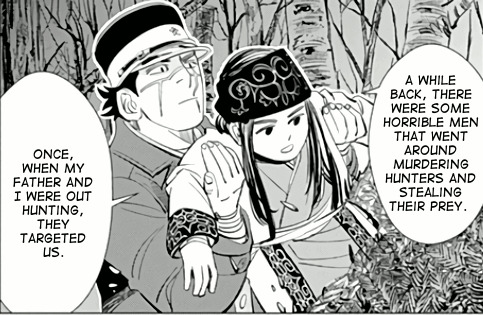
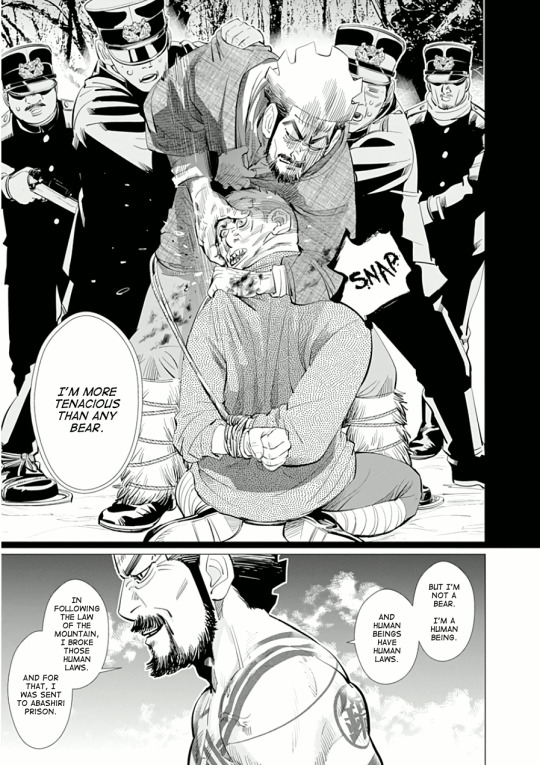
1898: Since placer gold was discovered in Bankenai, Hokkaido a gold rush occurred in Hokkaido.
1899: Deer hunting was prohibited entirely, and the Ainu lost raw materials essential to their ability to provide themselves with food and clothes. The Japanese government passed an act labelling the Ainu as "former aborigines", with the idea they would assimilate—this resulted in the Japanese government taking the land where the Ainu people lived and placing it from then on under Japanese control. Also at this time, the Ainu were granted automatic Japanese citizenship, effectively denying them the status of an indigenous group.
1902 (?): Supposedly the incident with the gold takes place (we know it happened 5 years before the story start and we can speculate the story started around 1907).
1903: The military settler colonists are incorporated into the 7th Division.
1904 (February 8): Start of the Russo-Japanese.
1904 (May 24-26): Battle of Nanshan to which takes part the first division, still under the second army and to which Sugimoto belonged.
1904 (June 6): The Third Army lands in Talien.
1904 (June): The First Division joins the Third Army.
1904 (August 1): Start of the Siege of Port Arthur.
1904 (September 20): Start of the Battle of 203 Meter Hill.

Sugimoto’s division takes part to the battle. (Chap 1)
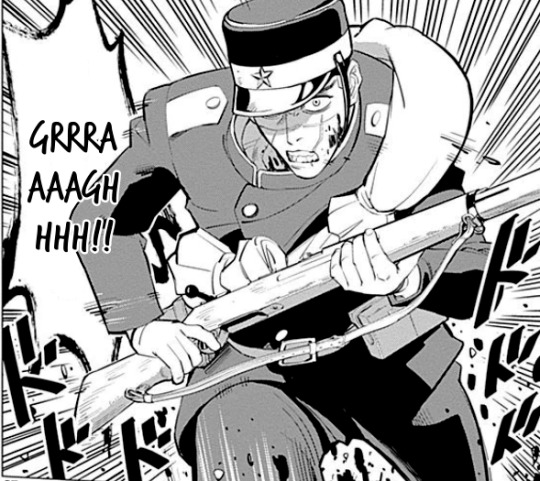
1904 (October): The 7th Division to which Tsurumi and his men belong, joins the Third Army. Around that time Tsurumi talks with Ogata about Yuusaku. The gist of the talk is how it could be better not to kill him but use him. (Chap 165)

Time after though Ogata will end up on killing Yuusaku (Chap 103).

Kenkichi also ends up dying during the battle (chap 76)
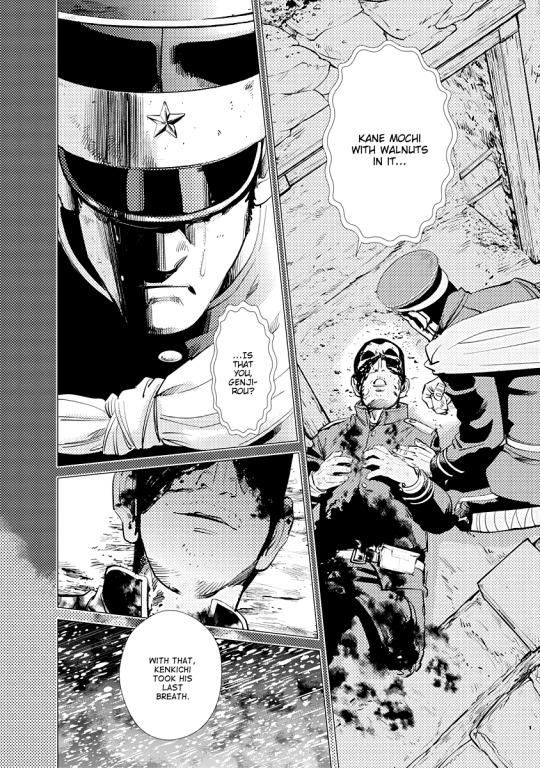
Kiroranke too took part to the battle, his use of explosive helping things greatly (chap 162)

1904 (December 5): End of the Battle of 203 Meter Hill. Tsurumi raises the Japanese flag on top of it (chap 31).
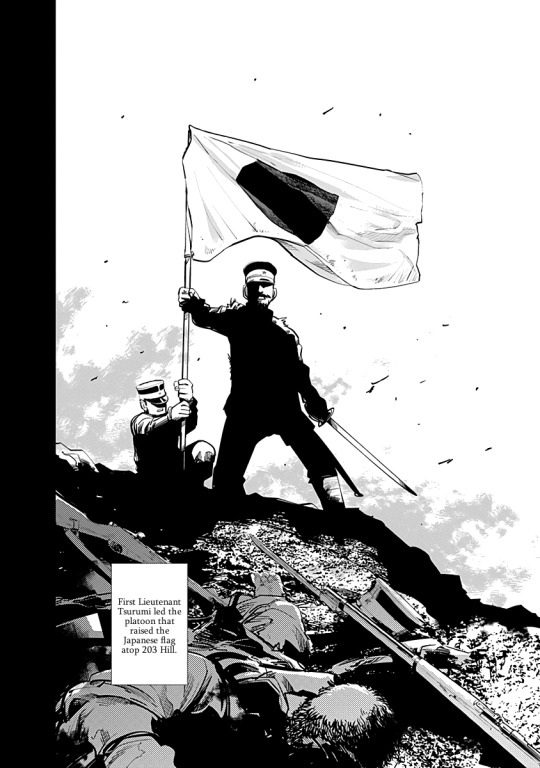
1905 (mid-february): Begins the mobilitation toward Mukden. Sugimoto and Toraji met while going toward Mukden and talk about Umeko (Chap 35)
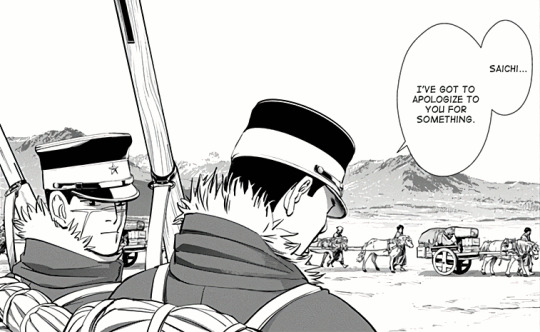
1905 (February 21): Start of the battle of Mudken.

During it, not only Tsurumi got wounded and received brain damage but he already had in mind his Ainu plan. (chap 149-150)
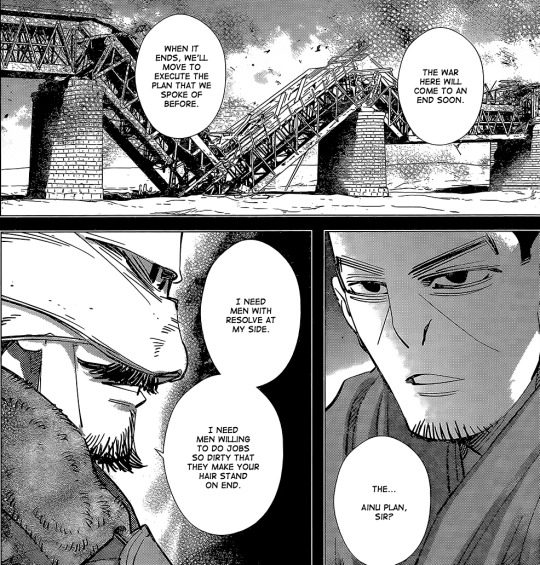

Toraji dies (Chap 150).

1905 (March 10): End of the battle of Mudken
1905: Before the end of the war some deserters from the Russian Army stop to a lighthouse in Russia and take away Svetlana, the daughter of the couple who lived there (Chap 168)
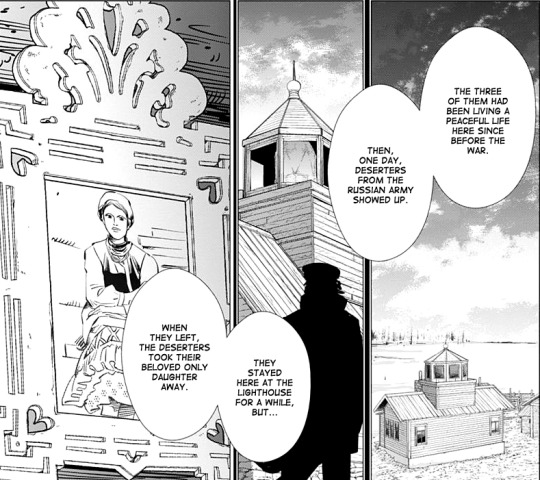
Sugimoto also almost kills a superior officer that pissed him off (Chap 1)
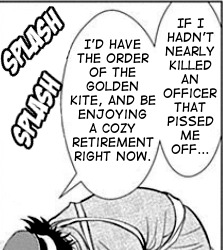
1905 (September 5): End of the Russo-Japanese War
1906 (January): The third Army which contained the 7th division is disbanded.
1906 (?): Hanazawa Koujirou dies (chap 31)

1906 (?) (spring): Sugimoto returns back home.

1907 (?) (late February): The series supposedly starts. - Sugimoto and Asirpa joins force to find the gold. (Chap 1-2) - Sugimoto and Asirpa capture prisoner number 1, Ogata kills him and Sugimoto seriously injures Ogata, causing him to end up being hospitalized. (Chap 3-5) - Shiraishi and Sugimoto meets. (Chap 6-7) - Ogata regains consciousness but, due to his broken jaw, can only write the word 'immortal' with his finger (Chap 7) - Tamai, Noma, Okada and Tanigaki go search who attacked Ogata. Tamai, Noma and Okada are killed by a bear while Tanigaki has his legs broken. (Chap 8-11) - Sugimoto drops by to Asirpa's village (Chap 11-13) - Hijitaka and Ushiyama join forces (Chap 12) - Tsurumi has Wada killed by Tsukiyama. (Chap 13)
1907 (?) (March): - Sugimoto leaves Asirpa's village and is captured by Tsurumi. In an attempt to escape he kills Nikaido Youhei. Nikaido Kouhei swears revenge. He, Asirpa and Shiraishi start to work together. (Chap 14-20) - Nagakura provides Hijikata some weapons. (Chap 20) - Hijikata, Ushiyama and some other men ask Shibukawa Senjirou and his men to cooperate with them. (Chap 21) - Nihei and Tanigaki join forces to kill Retar but Nihei dies and Tanigaki gets hit by an amappo and, as a result, he’s carried to Asirpa’s village. (Chap 22-31) - Huci tells Sugimoto, Asirpa and Shiraishi about the legend of the gold (Chap 30) - Hijikata informs Nagakura that the gold is much more than believed (Chap 30) - Tsurumi buys weapons from Mister Thomas (Chap 30-31) - Asirpa, Shiraishi and Sugimoto try to hunt an eagle. (Chap 31-32) - Hijikata, Nagakura and Ushiyama go to the city. While Hijikata and Nagakura retrieve Hijikata's old sword, Izumi-no-kami Kanesada, Ushiyama runs into Shiraishi but Shiraishi manages to escape him also thanks to the involvement of the 7th division. (Chap 33-34)
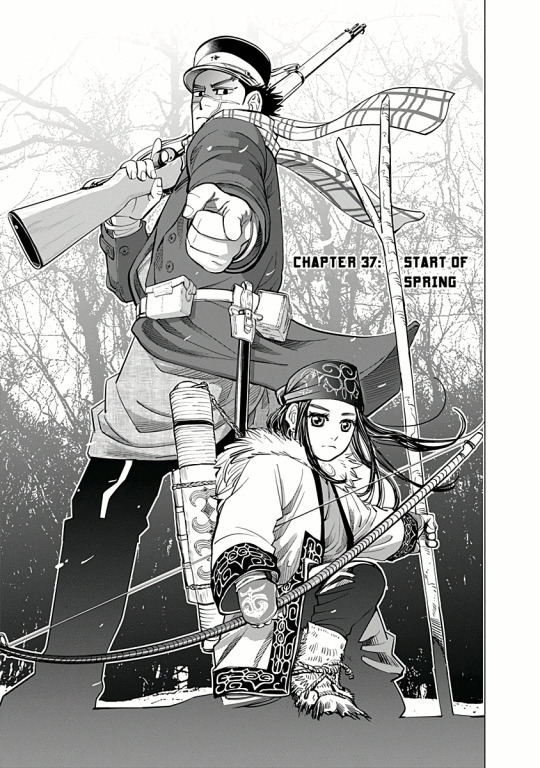
1907 (?) (Spring - April):- While hunting a Tanuki, Shiraishi, Sugimoto and Asirpa meet up wirh Ryu. Shiraishi tries to use Ryu to find Ushiyama but gets captured by him and forced to work for Hijikata, who gives him info to track down Henmi. (Chap 36-37) - One of Henmi's victims is found by Sugimoto and Asirpa. Shiraishi leads them to the herring fishery in which Henmi is hiding. Sugimoto rescues Henmi who fell in the water. At the same time Tsurumi and the 7th division are visiting the owner of the herring fishery and spot Sugimoto. As Sugimoto escapes from them he's also forced to fight Henmi who gets captured by an orca and dragged into the sea. Henmi dies, Sugimoto manages to recover his body and then escape from the 7th. Tsurumi discover the owner of the Herring fishery won't make him donations, that Ogata is missing from the hospital and that Nikaido has disappeared by SEVERAL DAYS. (Chap 37-42) - Ogata and Nikaido go to search Tamai and the others and meets up with Tanigaki. They believe Tanigaki is responsible for the death of Tamai and the others and try to kill him. Tanigaki manages to escape from them and have Nikaido be attacked by a bear. Tsurumi captures Nikaido and buy his loyalty promising him he will be allowed to kill Sugimoto. Nikaido betrays Komiya. Ogata manages to escape Tsurumi. (Chap 42-46) - While staying at a lodge Sugimoto's group meets up with Hijikata in disguise (Chap 43-44) - Sugimoto’s group will meet up with Kiroranke who saves Shiraishi from a huchen. Kiroranke warns Asirpa an old man is searching for Kochoube Asuko, Asirpa's Japanese name. He then tells her he knows what had happened at Abashiri and that Nopperabo is her father and joins forces with them (Chap 47-49) - Sugimoto's group and Kiroranke stop to Asirpa's village, where Tanigaki doesn't recognize Kiroranke. Ushiyama reaches the Sapporo World hotel. Sugimoto's group arrives at the same place short after. Shiraishi is captured by Ienaga. Sugimoto and Ushiyama become 'friends' and go eat something together with Asirpa, who grows fond of Ushiyama and Kiroranke. Later Ienaga tries to eat Asirpa and is caught by Sugimoto. Shiraishi escapes. Ushiyama lost in his lust for Ienaga, starts to chase her. In the end Kiroranke's explosive ends up dropped in the fire. Everyone escapes but Ushiyama and Ienaga are believed to be dead. (Chap 50-54)
29 notes
·
View notes
Text
Why should i visit?
-Japan

Japan is an island country in East Asia located in the northwest Pacific Ocean. It is bordered by the Sea of Japan to the west and extends from the Sea of Okhotsk in the north to the East China Sea and Taiwan in the south. Nearly the entire land area is taken up by the country’s four main islands; from north to south these are Hokkaido (Hokkaidō), Honshu (Honshū), Shikoku, and Kyushu (Kyūshū). Honshu is the largest of the four, followed in size by Hokkaido, Kyushu, and Shikoku. In addition, there are numerous smaller islands, the major groups of which are the Ryukyu (Nansei) Islands (including the island of Okinawa) to the south and west of Kyushu and the Izu, Bonin (Ogasawara), and Volcano (Kazan) islands to the south and east of central Honshu. The national capital, Tokyo (Tōkyō), in east-central Honshu, is one of the world’s most populous cities. DID YOU KNOW? Japan consists of over 6,000 islands. In Japan's early modern period, women would blacken their teeth with dye in a process called "ohaguro". 40% of publications sold in Japan are manga. Japan and Russia have never signed a peace treaty to end their World War II conflict. Consuming fugu, a poisonous blowfish delicacy, is illegal for Japanese royalty The Japanese landscape is rugged, with more than four-fifths of the land surface consisting of mountains. There are many active and dormant volcanoes, including Mount Fuji (Fuji-san), which, at an elevation of 12,388 feet (3,776 metres), is Japan’s highest mountain. Abundant precipitation and the generally mild temperatures throughout most of the country have produced a lush vegetation cover and, despite the mountainous terrain and generally poor soils, have made it possible to raise a variety of crops. Japan has a large and, to a great extent, ethnically homogeneous population, which is heavily concentrated in the low-lying areas along the Pacific coast of Honshu. Complexity and contrast are the keynotes of life in Japan—a country possessing an intricate and ancient cultural tradition yet one that, since 1950, has emerged as one of the world’s most economically and technologically advanced societies. Heavy emphasis is placed on education, and Japan is one of the world’s most literate countries. Tension between old and new is apparent in all phases of Japanese life. A characteristic sensitivity to natural beauty and a concern with form and balance are evident in such cities as Kyōto and Nara, as well as in Japan’s ubiquitous gardens. Even in the countryside, however, the impact of rapid Westernization is evident in many aspects of Japanese life. The agricultural regions are characterized by low population densities and well-ordered rice fields and fruit orchards, whereas the industrial and urbanized belt along the Pacific coast of Honshu is noted for its highly concentrated population, heavy industrialization, and environmental pollution Humans have occupied Japan for tens of thousands of years, but Japan’s recorded history begins only in the 1st century BCE, with mention in Chinese sources. Contact with China and Korea in the early centuries CE brought profound changes to Japan, including the Chinese writing system, Buddhism, and many artistic forms from the continent. The first steps at political unification of the country occurred in the late 4th and early 5th centuries CE under the Yamato court. A great civilization then developed first at Nara in the 8th century and then at Heian-kyō (now Kyōto) from the late 8th to the late 12th century. The seven centuries thereafter were a period of domination by military rulers culminating in near isolation from the outside world from the early 17th to the mid-19th century. The reopening of the country ushered in contact with the West and a time of unprecedented change. Japan sought to become a modern industrialized nation and pursued the acquisition of a large overseas empire, initially in Korea and China. By late 1941 this latter policy caused direct confrontation with the United States and its allies and to defeat in World War II (1939–45). Since.
1 note
·
View note
Text
Japan - General Information
capital city: Tokyo
Government: Unitary Parliamentary Constitutional Monarchy
Population: 126,150,000 (estimated in 2019)
Currency: Japanese Yen
Japan, island country lying off the east coast of Asia. It consists of a great string of islands in a northeast-southwest arc that stretches for approximately 1,500 miles (2,400 km) through the western North Pacific Ocean. Nearly the entire land area is taken up by the country’s four main islands; from north to south these are Hokkaido (Hokkaidō), Honshu (Honshū), Shikoku, and Kyushu (Kyūshū). Honshu is the largest of the four, followed in size by Hokkaido, Kyushu, and Shikoku. In addition, there are numerous smaller islands, the major groups of which are the Ryukyu (Nansei) Islands (including the island of Okinawa) to the south and west of Kyushu and the Izu, Bonin (Ogasawara), and Volcano (Kazan) islands to the south and east of central Honshu. The national capital, Tokyo (Tōkyō), in east-central Honshu, is one of the world’s most populous cities.

The Japanese landscape is rugged, with more than four-fifths of the land surface consisting of mountains. There are many active and dormant volcanoes, including Mount Fuji (Fuji-san), which, at an elevation of 12,388 feet (3,776 metres), is Japan’s highest mountain. Abundant precipitation and the generally mild temperatures throughout most of the country have produced a lush vegetation cover and, despite the mountainous terrain and generally poor soils, have made it possible to raise a variety of crops. Japan has a large and, to a great extent, ethnically homogeneous population, which is heavily concentrated in the low-lying areas along the Pacific coast of Honshu.

A bit of history:
Humans have occupied Japan for tens of thousands of years, but Japan’s recorded history begins only in the 1st century bce, with mention in Chinese sources. Contact with China and Korea in the early centuries ce brought profound changes to Japan, including the Chinese writing system, Buddhism, and many artistic forms from the continent. The first steps at political unification of the country occurred in the late 4th and early 5th centuries ce under the Yamato court. A great civilization then developed first at Nara in the 8th century and then at Heian-kyō (now Kyōto) from the late 8th to the late 12th century. The seven centuries thereafter were a period of domination by military rulers culminating in near isolation from the outside world from the early 17th to the mid-19th century.
The reopening of the country ushered in contact with the West and a time of unprecedented change. Japan sought to become a modern industrialized nation and pursued the acquisition of a large overseas empire, initially in Korea and China. By late 1941 this latter policy caused direct confrontation with the United States and its allies and to defeat in World War II (1939–45). Since the war, however, Japan’s spectacular economic growth, one of the greatest of any nation in that period, brought the country to the forefront of the world economy. It now is one of the world’s foremost manufacturing countries and traders of goods and is a global financial leader.
0 notes
Photo

In Giappone, nella regione di Hokkaidō, sorge uno splendido specchio d’acqua di origine naturale, che possiede una storia affascinante e tenebrosa. Stiamo parlando di Mashū-Ko, conosciuto anche come lago Mashū: è il più limpido del mondo, un record che vanta ormai da tanti decenni. Ma non solo, perché secondo le leggende sarebbe anche un lago maledetto, e i visitatori si recano ad ammirarlo a loro rischio e pericolo. Il lago Mashū si trova nel territorio del parco nazionale di Akan, uno dei più grandi e antichi del Giappone. Questa area è ricca di foreste e di vulcani, tra cui spicca proprio il vulcano Mashū, oggi inattivo. All’interno della sua caldera tanti secoli fa si è formato uno specchio d’acqua craterico che è ben presto divenuto famoso in tutto il mondo. Le acque del lago Mashū sono infatti così cristalline che, nel 1931, la visibilità si attestava a ben 40 metri di profondità, strappando il primato precedentemente detenuto dal lago Baikal. A renderlo così limpido è una serie di fattori molto particolari: si trova infatti a oltre 350 metri sul livello del mare e non ha immissari o emissari, venendo alimentato unicamente da acqua piovana e da acque di fusione. Inoltre non ospita forme di vita, che siano vegetali o animali. Il lago Mashū – Ph. makafushigi (iStock) Ma da qualche decennio a questa parte la situazione è cambiata. Con l’introduzione di due specie di trota e con l’inquinamento atmosferico in costante crescita, la limpidezza delle sue acque è diminuita. Oggi la visibilità è di circa 20 metri di profondità, ed è probabile che peggiorerà in futuro. Tuttavia, ciò non diminuisce il suo fascino incredibile che l’ha reso così famoso. Il lago Mashū è conosciuto per essere il più maledetto di tutti i tempi. A contribuire a questa leggenda, la fitta coltre di nebbia che costella praticamente in maniera costante la sua superficie. Secondo l’antica tradizione giapponese, questo specchio d’acqua è il “lago degli dei”. In molti vi si recano il più vicino possibile per trarne ispirazione e forza nei momenti difficili della loro vita, perché qui risiede uno spirito femminile particolarmente importante. Ma vedere le sue acque è pericolosissimo: la leggenda narra infatti che chi oserà tanto vivrà una grande sfortuna (gli uomini vedranno la loro carriera interrompersi e le donne avranno figli solo in tarda età). È probabile che questa storia misteriosa derivi dalla difficoltà con cui si può arrivare ad ammirare il lago, che è praticamente inaccessibile – è circondato da pareti vulcaniche di 200 metri. Per preservare le sue acque incontaminate, le autorità giapponesi hanno vietato l’accesso alle rive del lago Mashū, ma i più intrepidi possono godere della sua splendida vista possono percorrere un affascinante sentiero escursionistico dal quale lo sguardo può arrivare ai confini del cratere vulcanico. E voi, siete pronti ad immergervi in uno dei luoghi più suggestivi e maledetti del Giappone? Il lago Mashū – Ph. azuki25 (iStock) https://ift.tt/2OLbGrh Lago Mashū: lo specchio d’acqua più limpido e maledetto del Giappone In Giappone, nella regione di Hokkaidō, sorge uno splendido specchio d’acqua di origine naturale, che possiede una storia affascinante e tenebrosa. Stiamo parlando di Mashū-Ko, conosciuto anche come lago Mashū: è il più limpido del mondo, un record che vanta ormai da tanti decenni. Ma non solo, perché secondo le leggende sarebbe anche un lago maledetto, e i visitatori si recano ad ammirarlo a loro rischio e pericolo. Il lago Mashū si trova nel territorio del parco nazionale di Akan, uno dei più grandi e antichi del Giappone. Questa area è ricca di foreste e di vulcani, tra cui spicca proprio il vulcano Mashū, oggi inattivo. All’interno della sua caldera tanti secoli fa si è formato uno specchio d’acqua craterico che è ben presto divenuto famoso in tutto il mondo. Le acque del lago Mashū sono infatti così cristalline che, nel 1931, la visibilità si attestava a ben 40 metri di profondità, strappando il primato precedentemente detenuto dal lago Baikal. A renderlo così limpido è una serie di fattori molto particolari: si trova infatti a oltre 350 metri sul livello del mare e non ha immissari o emissari, venendo alimentato unicamente da acqua piovana e da acque di fusione. Inoltre non ospita forme di vita, che siano vegetali o animali. Il lago Mashū – Ph. makafushigi (iStock) Ma da qualche decennio a questa parte la situazione è cambiata. Con l’introduzione di due specie di trota e con l’inquinamento atmosferico in costante crescita, la limpidezza delle sue acque è diminuita. Oggi la visibilità è di circa 20 metri di profondità, ed è probabile che peggiorerà in futuro. Tuttavia, ciò non diminuisce il suo fascino incredibile che l’ha reso così famoso. Il lago Mashū è conosciuto per essere il più maledetto di tutti i tempi. A contribuire a questa leggenda, la fitta coltre di nebbia che costella praticamente in maniera costante la sua superficie. Secondo l’antica tradizione giapponese, questo specchio d’acqua è il “lago degli dei”. In molti vi si recano il più vicino possibile per trarne ispirazione e forza nei momenti difficili della loro vita, perché qui risiede uno spirito femminile particolarmente importante. Ma vedere le sue acque è pericolosissimo: la leggenda narra infatti che chi oserà tanto vivrà una grande sfortuna (gli uomini vedranno la loro carriera interrompersi e le donne avranno figli solo in tarda età). È probabile che questa storia misteriosa derivi dalla difficoltà con cui si può arrivare ad ammirare il lago, che è praticamente inaccessibile – è circondato da pareti vulcaniche di 200 metri. Per preservare le sue acque incontaminate, le autorità giapponesi hanno vietato l’accesso alle rive del lago Mashū, ma i più intrepidi possono godere della sua splendida vista possono percorrere un affascinante sentiero escursionistico dal quale lo sguardo può arrivare ai confini del cratere vulcanico. E voi, siete pronti ad immergervi in uno dei luoghi più suggestivi e maledetti del Giappone? Il lago Mashū – Ph. azuki25 (iStock) Il lago Mashū è uno dei più incantevoli del mondo, con le sue acque limpide e incontaminate: ma cela anche un antico segreto che affonda le sue radici nella leggenda…
0 notes
Text
Urup Island, Russia

Urup is an uninhabited volcanic island in the Kuril Islands chain in the south of the Sea of Okhotsk, northwest Pacific Ocean. Its name is derived from the Ainu language word for salmon trout. It was formerly known as Company's Land.
Urup has a roughly rectangular shape, measuring 120 kilometres (75 miles) along its long axis and approximately 20 kilometres (12 miles) along its narrow axis. It is the fourth largest of the Kuril Islands, with an area of 1,430 square kilometres (552 square miles). The highest point is Gora Ivao at 1,426 metres (4,678 ft).
In the spring and summer crested auklet, tufted puffin, and pigeon guillemot nest on the island; there is also a colony of black-legged kittiwake.
Urup was originally inhabited by the Ainu, the native peoples of the Kurils, Sakhalin and Hokkaidō. The first recorded visit by Europeans was in 1643, when a ship of the Dutch East India Company commanded by Maarten Gerritsz Vries landed, probably seeking furs.




#urup#island#russia#asia#travel#traveling#volcanic#magical#getaway#wanderlust#adventure#destination#tourist#tourism
17 notes
·
View notes
Link
1597 - Amiens surrenders to French King Henry IV 1867 - Congress creates 1st all-black university, Howard U in Washington, D.C. 1919 - US President Woodrow Wilson suffers a breakdown in Colorado, his health never recovers 1926 - PGA Championship Men's Golf, Salisbury GC: Walter Hagen defeats Leo Diegel, 5 and 3 in the final to win his 3rd consecutive PGA C'ship title 1957 - Soviet 7 year plan (1959-1965) announced 1965 - "Do I Hear a Waltz?" closes at 46th St Theater NYC after 220 performances 1981 - Sandra Day O'Connor becomes the first female US Supreme Court Justice 1989 - Archaeologists open Titus of Rhine grave in Amsterdam 2003 - A magnitude-8.0 earthquake strikes just offshore of Hokkaidō, Japan. 2008 - The "Celtic Tiger" slides into recession for the first time in over two decades, recording a 0.5% fall in second quarter GDP, following a 0.3% decline in the first quarter
More Historical Events »
from Historical Events | OnThisDay.com https://ift.tt/2n3LOeE September 25, 2019 at 09:33AM
0 notes
Text
Events 1.27 (after 1940)
1943 – World War II: The Eighth Air Force sorties ninety-one B-17s and B-24s to attack the U-boat construction yards at Wilhelmshaven, Germany. This was the first American bombing attack on Germany. 1944 – World War II: The 900-day Siege of Leningrad is lifted. 1945 – World War II: The Soviet 322nd Rifle Division liberates the remaining inmates of Auschwitz-Birkenau. 1951 – Nuclear testing at the Nevada Test Site begins with Operation Ranger. 1961 – The Soviet submarine S-80 sinks when its snorkel malfunctions, flooding the boat. 1965 – South Vietnamese Prime Minister Trần Văn Hương is removed by the military junta of Nguyễn Khánh. 1967 – Apollo program: Astronauts Gus Grissom, Ed White and Roger Chaffee are killed in a fire during a test of their Apollo 1 spacecraft at the Kennedy Space Center, Florida. 1967 – Cold War: The Soviet Union, the United States, and the United Kingdom sign the Outer Space Treaty in Washington, D.C., banning deployment of nuclear weapons in space, and limiting the usage of the Moon and other celestial bodies to peaceful purposes. 1973 – The Paris Peace Accords officially ends the Vietnam War. Colonel William Nolde is killed in action becoming the conflict's last recorded American combat casualty. 1980 – Through cooperation between the U.S. and Canadian governments, six American diplomats secretly escape hostilities in Iran in the culmination of the Canadian Caper. 1983 – The pilot shaft of the Seikan Tunnel, the world's longest sub-aqueous tunnel (53.85 km) between the Japanese islands of Honshū and Hokkaidō, breaks through. 1996 – In a military coup, Colonel Ibrahim Baré Maïnassara deposes the first democratically elected president of Niger, Mahamane Ousmane. 1996 – Germany first observes the International Holocaust Remembrance Day. 2002 – An explosion at a military storage facility in Lagos, Nigeria, kills at least 1,100 people and displaces over 20,000 others. 2003 – The first selections for the National Recording Registry are announced by the Library of Congress. 2010 – The 2009 Honduran constitutional crisis ends when Porfirio Lobo Sosa becomes the new President of Honduras. 2010 – Apple announces the iPad. 2011 – Arab Spring: The Yemeni Revolution begins as over 16,000 protestors demonstrate in Sana'a. 2011 – Within Ursa Minor, H1504+65, a white dwarf with the hottest known surface temperature in the universe at 200,000 K, was documented. 2013 – Two hundred and forty-two people die in a nightclub fire in the Brazilian city of Santa Maria, Rio Grande do Sul. 2014 – Rojava conflict: The Kobanî Canton declares its autonomy from the Syrian Arab Republic. 2017 – A naming ceremony for the chemical element tennessine takes place in the United States. 2023 – Protests and public outrage spark across the U.S. after the release of multiple videos by the Memphis Police Department showing officers punching, kicking, and pepper spraying Tyre Nichols as a result of running away from a traffic stop, which resulted him dying in the hospital three days later after the incident. 2023 – A shooting at a synagogue in Neve Yaakov, East Jerusalem, kills seven people and injures three others.
0 notes
Text
Events 1.27
98 – Trajan succeeds his adoptive father Nerva as Roman emperor; under his rule the Roman Empire will reach its maximum extent. 945 – The co-emperors Stephen and Constantine are overthrown and forced to become monks by Constantine VII, who becomes sole emperor of the Byzantine Empire. 1186 – Henry VI, the son and heir of the Holy Roman Emperor Frederick I, marries Constance of Sicily. 1302 – Dante Alighieri is condemned in absentia and exiled from Florence. 1343 – Pope Clement VI issues the papal bull Unigenitus to justify the power of the pope and the use of indulgences. Nearly 200 years later, Martin Luther would protest this. 1606 – Gunpowder Plot: The trial of Guy Fawkes and other conspirators begins, ending with their execution on January 31. 1695 – Mustafa II becomes the Ottoman sultan and Caliph of Islam in Istanbul on the death of Ahmed II. Mustafa rules until his abdication in 1703. 1759 – Spanish forces clash with indigenous Huilliches of southern Chile in the battle of Río Bueno. 1776 – American Revolutionary War: Henry Knox's "noble train of artillery" arrives in Cambridge, Massachusetts. 1785 – The University of Georgia is founded, the first public university in the United States. 1820 – A Russian expedition led by Fabian Gottlieb von Bellingshausen and Mikhail Petrovich Lazarev discovers the Antarctic continent, approaching the Antarctic coast. 1825 – The U.S. Congress approves Indian Territory (in what is present-day Oklahoma), clearing the way for forced relocation of the Eastern Indians on the "Trail of Tears". 1868 – Boshin War: The Battle of Toba–Fushimi begins, between forces of the Tokugawa shogunate and pro-Imperial factions; it will end in defeat for the shogunate, and is a pivotal point in the Meiji Restoration. 1869 – Boshin War: Tokugawa rebels establish the Ezo Republic in Hokkaidō. 1874 – Modest Mussorgsky's opera Boris Godunov premieres in Mariinsky Theatre in St.Petersburg 1880 – Thomas Edison receives a patent for his incandescent lamp. 1916 – World War I: The British government passes the Military Service Act that introduces conscription in the United Kingdom. 1918 – Beginning of the Finnish Civil War. 1924 – Six days after his death Lenin's body is carried into a specially erected mausoleum. 1927 – Ibn Saud takes the title of King of Nejd. 1939 – First flight of the Lockheed P-38 Lightning. 1943 – World War II: The Eighth Air Force sorties ninety-one B-17s and B-24s to attack the U-boat construction yards at Wilhelmshaven, Germany. This was the first American bombing attack on Germany. 1944 – World War II: The 900-day Siege of Leningrad is lifted. 1945 – World War II: The Soviet 322nd Rifle Division liberates the remaining inmates of Auschwitz-Birkenau. 1951 – Nuclear testing at the Nevada Test Site begins with Operation Ranger. 1961 – The Soviet submarine S-80 sinks when its snorkel malfunctions, flooding the boat. 1965 – South Vietnamese Prime Minister Trần Văn Hương is removed by the military junta of Nguyễn Khánh. 1967 – Apollo program: Astronauts Gus Grissom, Ed White and Roger Chaffee are killed in a fire during a test of their Apollo 1 spacecraft at the Kennedy Space Center, Florida. 1967 – Cold War: The Soviet Union, the United States, and the United Kingdom sign the Outer Space Treaty in Washington, D.C., banning deployment of nuclear weapons in space, and limiting the usage of the Moon and other celestial bodies to peaceful purposes. 1973 – The Paris Peace Accords officially ends the Vietnam War. Colonel William Nolde is killed in action becoming the conflict's last recorded American combat casualty. 1980 – Through cooperation between the U.S. and Canadian governments, six American diplomats secretly escape hostilities in Iran in the culmination of the Canadian Caper. 1983 – The pilot shaft of the Seikan Tunnel, the world's longest sub-aqueous tunnel (53.85 km) between the Japanese islands of Honshū and Hokkaidō, breaks through. 1996 – In a military coup, Colonel Ibrahim Baré Maïnassara deposes the first democratically elected president of Niger, Mahamane Ousmane. 1996 – Germany first observes the International Holocaust Remembrance Day. 2002 – An explosion at a military storage facility in Lagos, Nigeria, kills at least 1,100 people and displaces over 20,000 others. 2003 – The first selections for the National Recording Registry are announced by the Library of Congress. 2010 – The 2009 Honduran constitutional crisis ends when Porfirio Lobo Sosa becomes the new President of Honduras. 2010 – Apple announces the iPad. 2011 – Arab Spring: The Yemeni Revolution begins as over 16,000 protestors demonstrate in Sana'a. 2011 – Within Ursa Minor, H1504+65, a white dwarf with the hottest known surface temperature in the universe at 200,000 K, was documented. 2013 – Two hundred and forty-two people die in a nightclub fire in the Brazilian city of Santa Maria, Rio Grande do Sul. 2014 – Rojava conflict: The Kobanî Canton declares its autonomy from the Syrian Arab Republic. 2017 – A naming ceremony for the chemical element tennessine takes place in the United States.
0 notes
Text
Events 1.28
98 – Trajan succeeds his adoptive father Nerva as Roman emperor; under his rule the Roman Empire will reach its maximum extent. 945 – The co-emperors Stephen and Constantine are overthrown and forced to become monks by Constantine VII, who becomes sole emperor of the Byzantine Empire. 1186 – Henry VI, the son and heir of the Holy Roman Emperor Frederick I, marries Constance of Sicily. 1302 – Dante Alighieri is condemned in absentia and exiled from Florence. 1343 – Pope Clement VI issues the papal bull Unigenitus to justify the power of the pope and the use of indulgences. Nearly 200 years later, Martin Luther would protest this. 1606 – Gunpowder Plot: The trial of Guy Fawkes and other conspirators begins, ending with their execution on January 31. 1695 – Mustafa II becomes the Ottoman sultan and Caliph of Islam in Istanbul on the death of Ahmed II. Mustafa rules until his abdication in 1703. 1759 – Spanish forces defeat indigenous Huilliches of southern Chile in the battle of Río Bueno. 1776 – American Revolutionary War: Henry Knox's "noble train of artillery" arrives in Cambridge, Massachusetts. 1785 – The University of Georgia is founded, the first public university in the United States. 1820 – A Russian expedition led by Fabian Gottlieb von Bellingshausen and Mikhail Petrovich Lazarev discovers the Antarctic continent, approaching the Antarctic coast. 1825 – The U.S. Congress approves Indian Territory (in what is present-day Oklahoma), clearing the way for forced relocation of the Eastern Indians on the "Trail of Tears". 1868 – Boshin War: The Battle of Toba–Fushimi begins, between forces of the Tokugawa shogunate and pro-Imperial factions; it will end in defeat for the shogunate, and is a pivotal point in the Meiji Restoration. 1869 – Boshin War: Tokugawa rebels establish the Ezo Republic in Hokkaidō. 1874 – Modest Mussorgsky's opera Boris Godunov premieres in Mariinsky Theatre in St.Petersburg 1880 – Thomas Edison receives a patent for his incandescent lamp. 1916 – World War I: The British government passes the Military Service Act that introduces conscription in the United Kingdom. 1918 – Beginning of the Finnish Civil War. 1924 – Three days after his death Lenin's body is carried into a specially erected mausoleum. 1927 – Ibn Saud takes the title of King of Nejd. 1939 – First flight of the Lockheed P-38 Lightning. 1943 – World War II: The Eighth Air Force sorties ninety-one B-17s and B-24s to attack the U-boat construction yards at Wilhelmshaven, Germany. This was the first American bombing attack on Germany. 1944 – World War II: The 900-day Siege of Leningrad is lifted. 1945 – World War II: The Soviet 322nd Rifle Division liberates the remaining inmates of Auschwitz-Birkenau. 1951 – Nuclear testing at the Nevada Test Site begins with Operation Ranger. 1961 – The Soviet submarine S-80 sinks when its snorkel malfunctions, flooding the boat. 1965 – South Vietnamese Prime Minister Trần Văn Hương is removed by the military junta of Nguyễn Khánh. 1967 – Apollo program: Astronauts Gus Grissom, Ed White and Roger Chaffee are killed in a fire during a test of their Apollo 1 spacecraft at the Kennedy Space Center, Florida. 1967 – Cold War: The Soviet Union, the United States, and the United Kingdom sign the Outer Space Treaty in Washington, D.C., banning deployment of nuclear weapons in space, and limiting the usage of the Moon and other celestial bodies to peaceful purposes. 1973 – The Paris Peace Accords officially ends the Vietnam War. Colonel William Nolde is killed in action becoming the conflict's last recorded American combat casualty. 1980 – Through cooperation between the U.S. and Canadian governments, six American diplomats secretly escape hostilities in Iran in the culmination of the Canadian Caper. 1983 – The pilot shaft of the Seikan Tunnel, the world's longest sub-aqueous tunnel (53.85 km) between the Japanese islands of Honshū and Hokkaidō, breaks through. 1996 – In a military coup, Colonel Ibrahim Baré Maïnassara deposes the first democratically elected president of Niger, Mahamane Ousmane. 1996 – Germany first observes the International Holocaust Remembrance Day. 2002 – An explosion at a military storage facility in Lagos, Nigeria, kills at least 1,100 people and displaces over 20,000 others. 2003 – The first selections for the National Recording Registry are announced by the Library of Congress. 2010 – The 2009 Honduran constitutional crisis ends when Porfirio Lobo Sosa becomes the new President of Honduras. 2010 – Apple announces the iPad. 2011 – Arab Spring: The Yemeni Revolution begins as over 16,000 protestors demonstrate in Sana'a. 2013 – Two hundred and forty-two people die in a nightclub fire in the Brazilian city of Santa Maria, Rio Grande do Sul. 2014 – Rojava conflict: The Kobanî Canton declares its autonomy from the Syrian Arab Republic. 2017 – A naming ceremony for the chemical element tennessine takes place in the United States.
0 notes
Text
Events 1.27
AD 98 – Trajan succeeds his adoptive father Nerva as Roman emperor; under his rule the Roman Empire will reach its maximum extent. 1186 – Henry VI, the son and heir of the Holy Roman Emperor Frederick I, marries Constance of Sicily. 1302 – Dante Alighieri is condemned in absentia and exiled from Florence. 1343 – Pope Clement VI issues the papal bull Unigenitus to justify the power of the pope and the use of indulgences. Nearly 200 years later, Martin Luther would protest this. 1606 – Gunpowder Plot: The trial of Guy Fawkes and other conspirators begins, ending with their execution on January 31. 1695 – Mustafa II becomes the Ottoman sultan and Caliph of Islam in Istanbul on the death of Ahmed II. Mustafa rules until his abdication in 1703. 1759 – Spanish forces defeat indigenous Huilliches of southern Chile in the battle of Río Bueno. 1776 – American Revolutionary War: Henry Knox's "noble train of artillery" arrives in Cambridge, Massachusetts. 1785 – The University of Georgia is founded, the first public university in the United States. 1820 – A Russian expedition led by Fabian Gottlieb von Bellingshausen and Mikhail Petrovich Lazarev discovers the Antarctic continent, approaching the Antarctic coast. 1825 – The U.S. Congress approves Indian Territory (in what is present-day Oklahoma), clearing the way for forced relocation of the Eastern Indians on the "Trail of Tears". 1868 – Boshin War: The Battle of Toba–Fushimi begins, between forces of the Tokugawa shogunate and pro-Imperial factions; it will end in defeat for the shogunate, and is a pivotal point in the Meiji Restoration. 1869 – Boshin War: Tokugawa rebels establish the Ezo Republic in Hokkaidō. 1874 – Modest Mussorgsky's opera Boris Godunov premieres in Mariinsky Theatre in St.Petersburg 1880 – Thomas Edison receives a patent for his incandescent lamp. 1916 – World War I: The British government passed a legislation that introduced conscription in the United Kingdom. 1918 – Beginning of the Finnish Civil War. 1924 – Three days after his death was Lenin's body carried to Red Square into the specially erected mausoleum. 1927 – Ibn Saud takes the title of King of Nejd. 1939 – First flight of the Lockheed P-38 Lightning. 1943 – World War II: The Eighth Air Force sorties ninety-one B-17s and B-24s to attack the U-boat construction yards at Wilhelmshaven, Germany. This was the first American bombing attack on Germany. 1944 – World War II: The 900-day Siege of Leningrad is lifted. 1945 – World War II: The Soviet 322nd Rifle Division liberates the remaining inmates of Auschwitz-Birkenau. 1951 – Nuclear testing at the Nevada Test Site begins with Operation Ranger. 1961 – The Soviet submarine S-80 sinks when its snorkel malfunctions, flooding the boat. 1965 – South Vietnamese Prime Minister Tran Van Huong was removed by the military junta of Nguyen Khanh. 1967 – Apollo program: Astronauts Gus Grissom, Ed White and Roger Chaffee are killed in a fire during a test of their Apollo 1 spacecraft at the Kennedy Space Center, Florida. 1967 – Cold War: The Soviet Union, the United States, and the United Kingdom sign the Outer Space Treaty in Washington, D.C., banning deployment of nuclear weapons in space, and limiting use of the Moon and other celestial bodies to peaceful purposes. 1973 – The Paris Peace Accords officially end the Vietnam War. Colonel William Nolde is killed in action becoming the conflict's last recorded American combat casualty. 1980 – Through cooperation between the U.S. and Canadian governments, six American diplomats secretly escape hostilities in Iran in the culmination of the Canadian Caper. 1983 – The pilot shaft of the Seikan Tunnel, the world's longest sub-aqueous tunnel (53.85 km) between the Japanese islands of Honshū and Hokkaidō, breaks through. 1996 – In a military coup, Colonel Ibrahim Baré Maïnassara deposes the first democratically elected president of Niger, Mahamane Ousmane. 1996 – Germany first observes the International Holocaust Remembrance Day. 2002 – An explosion at a military storage facility in Lagos, Nigeria, kills at least 1,100 people and displaces over 20,000 others. 2003 – The first selections for the National Recording Registry are announced by the Library of Congress. 2010 – The 2009 Honduran constitutional crisis ends when Porfirio Lobo Sosa becomes the new President of Honduras. 2011 – Arab Spring: The Yemeni Revolution begins as over 16,000 protestors demonstrate in Sana'a. 2013 – Two hundred and forty-two people die in a nightclub fire in the Brazilian city of Santa Maria, Rio Grande do Sul.
0 notes
Text
Events 1.27
AD 98 – Trajan succeeds his adoptive father Nerva as Roman emperor; under his rule the Roman Empire will reach its maximum extent. 1186 – Henry VI, the son and heir of the Holy Roman Emperor Frederick I, marries Constance of Sicily. 1302 – Dante Alighieri is exiled from Florence. 1343 – Pope Clement VI issues the papal bull Unigenitus to justify the power of the pope and the use of indulgences. Nearly 200 years later, Martin Luther would protest this. 1606 – Gunpowder Plot: The trial of Guy Fawkes and other conspirators begins, ending with their execution on January 31. 1695 – Mustafa II becomes the Ottoman sultan and Caliph of Islam in Istanbul on the death of Ahmed II. Mustafa rules until his abdication in 1703. 1776 – American Revolutionary War: Henry Knox's "noble train of artillery" arrives in Cambridge, Massachusetts. 1785 – The University of Georgia is founded, the first public university in the United States. 1820 – A Russian expedition led by Fabian Gottlieb von Bellingshausen and Mikhail Petrovich Lazarev discovers the Antarctic continent, approaching the Antarctic coast. 1825 – The U.S. Congress approves Indian Territory (in what is present-day Oklahoma), clearing the way for forced relocation of the Eastern Indians on the "Trail of Tears". 1868 – Boshin War: The Battle of Toba–Fushimi begins, between forces of the Tokugawa shogunate and pro-Imperial factions; it will end in defeat for the shogunate, and is a pivotal point in the Meiji Restoration. 1869 – Boshin War: Tokugawa rebels establish the Ezo Republic in Hokkaidō. 1880 – Thomas Edison receives a patent for his incandescent lamp. 1916 – World War I: The British government passed a legislation that introduced conscription in the United Kingdom. 1918 – Beginning of the Finnish Civil War. 1927 – Ibn Saud takes the title of King of Nejd. 1939 – First flight of the Lockheed P-38 Lightning. 1943 – World War II: The Eighth Air Force sorties ninety-one B-17s and B-24s to attack the U-boat construction yards at Wilhelmshaven, Germany. This was the first American bombing attack on Germany. 1944 – World War II: The 900-day Siege of Leningrad is lifted. 1945 – World War II: The Soviet 322nd Rifle Division liberates the remaining inmates of Auschwitz-Birkenau. 1951 – Nuclear testing at the Nevada Test Site begins with Operation Ranger. 1961 – The Soviet submarine S-80 sinks when its snorkel malfunctions, flooding the boat. 1967 – Apollo program: Astronauts Gus Grissom, Ed White and Roger Chaffee are killed in a fire during a test of their Apollo 1 spacecraft at the Kennedy Space Center, Florida. 1967 – Cold War: The Soviet Union, the United States, and the United Kingdom sign the Outer Space Treaty in Washington, D.C., banning deployment of nuclear weapons in space, and limiting use of the Moon and other celestial bodies to peaceful purposes. 1973 – The Paris Peace Accords officially end the Vietnam War. Colonel William Nolde is killed in action becoming the conflict's last recorded American combat casualty. 1980 – Through cooperation between the U.S. and Canadian governments, six American diplomats secretly escape hostilities in Iran in the culmination of the Canadian Caper. 1983 – The pilot shaft of the Seikan Tunnel, the world's longest sub-aqueous tunnel (53.85 km) between the Japanese islands of Honshū and Hokkaidō, breaks through. 1996 – In a military coup, Colonel Ibrahim Baré Maïnassara deposes the first democratically elected president of Niger, Mahamane Ousmane. 1996 – Germany first observes the International Holocaust Remembrance Day. 2002 – An explosion at a military storage facility in Lagos, Nigeria, kills at least 1,100 people and displaces over 20,000 others. 2003 – The first selections for the National Recording Registry are announced by the Library of Congress. 2010 – The 2009 Honduran constitutional crisis ends when Porfirio Lobo Sosa becomes the new President of Honduras. 2011 – Arab Spring: The Yemeni Revolution begins as over 16,000 protestors demonstrate in Sana'a. 2013 – Two hundred and forty-two people die in a nightclub fire in the Brazilian city of Santa Maria, Rio Grande do Sul.
0 notes
Text
Events 1.27
AD 98 – Trajan succeeds his adoptive father Nerva as Roman emperor; under his rule the Roman Empire would reach its maximum extent. 945 – The co-emperors Stephen and Constantine are overthrown and forced to become monk by Constantine VII, who becomes sole emperor of the Byzantine Empire. 1186 – Henry VI, the son and heir of the Holy Roman Emperor Frederick I, marries Constance of Sicily. 1302 – Dante Alighieri is exiled from Florence. 1343 – Pope Clement VI issues the papal bull Unigenitus to justify the power of the pope and the use of indulgences. Nearly 200 years later, Martin Luther would protest this. 1606 – Gunpowder Plot: The trial of Guy Fawkes and other conspirators begins, ending with their execution on January 31. 1695 – Mustafa II becomes the Ottoman sultan and Caliph of Islam in Istanbul on the death of Ahmed II. Mustafa rules until his abdication in 1703. 1776 – American Revolutionary War: Henry Knox's "noble train of artillery" arrives in Cambridge, Massachusetts. 1785 – The University of Georgia is founded, the first public university in the United States. 1820 – A Russian expedition led by Fabian Gottlieb von Bellingshausen and Mikhail Petrovich Lazarev discovers the Antarctic continent, approaching the Antarctic coast. 1825 – The U.S. Congress approves Indian Territory (in what is present-day Oklahoma), clearing the way for forced relocation of the Eastern Indians on the "Trail of Tears". 1868 – Boshin War: The Battle of Toba–Fushimi between forces of the Tokugawa shogunate and pro-Imperial factions begins, which will end in defeat for the shogunate, and is a pivotal point in the Meiji Restoration. 1869 – Boshin War: Tokugawa rebels establish the Ezo Republic in Hokkaidō. 1880 – Thomas Edison receives the patent on the incandescent lamp. 1916 – World War I: The British government passed a legislation that introduced conscription in the United Kingdom. 1918 – Beginning of the Finnish Civil War. 1927 – Ibn Saud takes the title of King of Nejd. 1939 – First flight of the Lockheed P-38 Lightning. 1943 – World War II: The Eighth Air Force sorties ninety-one B-17s and B-24s to attack the U-boat construction yards at Wilhelmshaven, Germany. This was the first American bombing attack on Germany. 1944 – World War II: The 900-day Siege of Leningrad is lifted. 1945 – World War II: The Soviet 322nd Rifle Division liberates the remaining inmates of Auschwitz-Birkenau. 1951 – Nuclear testing at the Nevada Test Site begins with Operation Ranger. 1961 – The Soviet submarine S-80 sinks when its snorkel malfunctions, flooding the boat. 1967 – Apollo program: Astronauts Gus Grissom, Ed White and Roger Chaffee are killed in a fire during a test of their Apollo 1 spacecraft at the Kennedy Space Center, Florida. 1967 – Cold War: The Soviet Union, the United States, and the United Kingdom sign the Outer Space Treaty in Washington, D.C., banning deployment of nuclear weapons in space, and limiting use of the Moon and other celestial bodies to peaceful purposes. 1973 – The Paris Peace Accords officially end the Vietnam War. Colonel William Nolde is killed in action becoming the conflict's last recorded American combat casualty. 1980 – Through cooperation between the U.S. and Canadian governments, six American diplomats secretly escape hostilities in Iran in the culmination of the Canadian Caper. 1983 – The pilot shaft of the Seikan Tunnel, the world's longest sub-aqueous tunnel (53.85 km) between the Japanese islands of Honshū and Hokkaidō, breaks through. 1996 – In a military coup, Colonel Ibrahim Baré Maïnassara deposes the first democratically elected president of Niger, Mahamane Ousmane. 1996 – Germany first observes the International Holocaust Remembrance Day. 2002 – An explosion at a military storage facility in Lagos, Nigeria, kills at least 1,100 people and displaces over 20,000 others. 2003 – The first selections for the National Recording Registry are announced by the Library of Congress. 2010 – The 2009 Honduran constitutional crisis ends when Porfirio Lobo Sosa becomes the new President of Honduras. 2011 – Arab Spring: The Yemeni Revolution begins as over 16,000 protestors demonstrate in Sana'a. 2013 – Two hundred and forty-two people die in a nightclub fire in the Brazilian city of Santa Maria, Rio Grande do Sul.
0 notes
Text
Events 1.27
AD 98 – Trajan succeeded his adoptive father Nerva as Roman emperor; under his rule the Roman Empire would reach its maximum extent. 945 – The co-emperors Stephen and Constantine are overthrown. Constantine VII becomes sole emperor of the Byzantine Empire. 1142 – Song dynasty General Yue Fei is executed. 1186 – Henry VI, the son and heir of the Holy Roman Emperor Frederick I, marries Constance of Sicily. 1302 – Dante Alighieri is exiled from Florence. 1343 – Pope Clement VI issues the papal bull Unigenitus to justify the power of the pope and the use of indulgences. Nearly 200 years later, Martin Luther would protest this. 1606 – Gunpowder Plot: The trial of Guy Fawkes and other conspirators begins, ending with their execution on January 31. 1695 – Mustafa II becomes the Ottoman sultan and Caliph of Islam in Istanbul on the death of Ahmed II. Mustafa rules until his abdication in 1703. 1776 – American Revolutionary War: Henry Knox's "noble train of artillery" arrives in Cambridge, Massachusetts. 1785 – The University of Georgia is founded, the first public university in the United States. 1820 – A Russian expedition led by Fabian Gottlieb von Bellingshausen and Mikhail Petrovich Lazarev discovers the Antarctic continent, approaching the Antarctic coast. 1825 – The U.S. Congress approves Indian Territory (in what is present-day Oklahoma), clearing the way for forced relocation of the Eastern Indians on the "Trail of Tears". 1868 – Boshin War: The Battle of Toba–Fushimi between forces of the Tokugawa shogunate and pro-Imperial factions begins, which will end in defeat for the shogunate, and is a pivotal point in the Meiji Restoration. 1869 – Boshin War: Tokugawa rebels establish the Ezo Republic in Hokkaidō. 1880 – Thomas Edison receives the patent on the incandescent lamp. 1927 – Ibn Saud takes the title of King of Nejd. 1939 – First flight of the Lockheed P-38 Lightning. 1943 – World War II: The Eighth Air Force sorties ninety-one B-17s and B-24s to attack the U-boat construction yards at Wilhelmshaven, Germany. This was the first American bombing attack on Germany. 1944 – World War II: The 900-day Siege of Leningrad is lifted. 1945 – World War II: The Red Army liberates the remaining inmates of Auschwitz-Birkenau. 1951 – Nuclear testing at the Nevada Test Site begins with Operation Ranger. 1961 – The Soviet submarine S-80 sinks when its snorkel malfunctions, flooding the boat. 1967 – Astronauts Gus Grissom, Ed White and Roger Chaffee are killed in a fire during a test of their Apollo 1 spacecraft at the Kennedy Space Center, Florida. 1967 – United States, United Kingdom, and Soviet Union sign the Outer Space Treaty in Washington, D.C., banning deployment of nuclear weapons in space, and limiting use of the Moon and other celestial bodies to peaceful purposes. 1973 – The Paris Peace Accords officially end the Vietnam War. Colonel William Nolde is killed in action becoming the conflict's last recorded American combat casualty. 1980 – Through cooperation between the U.S. and Canadian governments, six American diplomats secretly escape hostilities in Iran in the culmination of the Canadian Caper. 1983 – The pilot shaft of the Seikan Tunnel, the world's longest sub-aqueous tunnel (53.85 km) between the Japanese islands of Honshū and Hokkaidō, breaks through. 1996 – In a military coup Colonel Ibrahim Baré Maïnassara deposes the first democratically elected president of Niger, Mahamane Ousmane. 1996 – Germany first observes International Holocaust Remembrance Day. 2002 – An explosion at a military storage facility in Lagos, Nigeria, kills at least 1,100 people and displaces over 20,000 others. 2003 – The first selections for the National Recording Registry are announced by the Library of Congress. 2010 – The 2009 Honduran constitutional crisis ends when Porfirio Lobo Sosa becomes the new President of Honduras. 2011 – Arab Spring: The Yemeni Revolution begins as over 16,000 protestors demonstrate in Sana'a. 2013 – Two hundred and forty-two people die in a nightclub fire in the Brazilian city of Santa Maria, Rio Grande do Sul.
0 notes